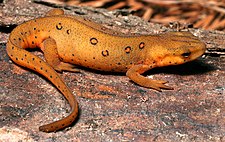Newt
| Newt | |
|---|---|
| Scientific classification | |
| Domain: | Eukaryota |
| Kingdom: | Animalia |
| Phylum: | Chordata |
| Class: | Amphibia |
| Order: | Urodela |
| Family: | Salamandridae |
| Subfamily: | Pleurodelinae |
| Genera | |
|
14–17 living and six fossil genera | |

The bright aposematic colouration warns predators of its highly toxic skin.
Newts or efts are small amphibia. They are in a subfamily of the salamanders. They are found in North America, Europe, and North Asia.
Life cycle[change | change source]
Females lay eggs and leave them. Tadpoles are born from those eggs.
Newts have three life stages. First as a tiny aquatic larva, which gradually undergoes metamorphosis. Then they leave the water for a year as a juvenile called an eft. They go back in the water to breed as adults.
In some species the adults stay in water for the rest of their lives. Others are land-based, but return to water each year to breed.
Defences[change | change source]
Many newts produce toxins in their skin secretions as a defence against predators. They have bright skin colours as a warning to other animals.
Taricha newts of western North America are particularly toxic; the rough-skinned newt Taricha granulosa of the Pacific Northwest produces more than enough tetrodotoxin to kill an adult human. Recently, a 29-year-old man in Coos Bay, Oregon, who had been drinking heavily, swallowed a rough-skin newt for a dare; he died later that day despite hospital treatment.[2]
Most newts can be safely handled, provided that the toxins they produce are not ingested or allowed to come in contact with mucous membranes, or breaks in the skin.[2] After handling, proper hand-washing techniques should be followed due to the risk from the toxins they produce and bacteria they carry, such as salmonella.[3][4] It is illegal to handle or disturb great crested newts in the UK without a licence.[5]
[change | change source]
The term "newt" has traditionally been used as a functional term for salamanders living in water, and not a systematic unit. The relationship between the genera has been uncertain, though they may be a natural systematic unit. Newer molecular analysis tend to suggest they actually do form a clade.[6][7][8] Newts only appear in one subfamily of salamanders, the Pleurodelinae (of the family Salamandridae).[9] Some genera occasionally listed as Pleurodelinae are not newts (Salamandrina and Euproctus).
References[change | change source]
- ↑ Zhang, Peng; Papenfuss, Theodore J.; Wake, Marvalee H.; Qu, Lianghu; Wake, David B. (2008). "Phylogeny and biogeography of the family Salamandridae (Amphibia: Caudata) inferred from complete mitochondrial genomes" (PDF). Molecular Phylogenetics and Evolution. 49 (2): 586–597. doi:10.1016/j.ympev.2008.08.020. ISSN 1055-7903. PMID 18801447. Archived from the original (PDF) on 2017-02-02. Retrieved 2018-05-28.
- ↑ 2.0 2.1 see caudata.org Archived 2013-05-31 at the Wayback Machine Accessed 2007-11-28
- ↑ Salmonellosis - Reptiles and Amphibians Accessed 2007-11-28
- ↑ CDC MMWR: Reptile-Associated Salmonellosis: Selected States, 1998-2002 Accessed 2007-11-28
- ↑ bbc.co.uk Factfile 479 Archived 2012-05-24 at Archive.today Accessed 2007-11-28
- ↑ Titus T.A. & A. Larson 1995. A molecular phylogenetic perspective on the evolutionary radiation of the salamander family Salamandridae. Systematic Biology 44, 125-151.
- ↑ Steinfartz S. S. Vicario, J.W. Arntzen & A. Caccone 2006. A Bayesian approach on molecules and behavior: reconsidering phylogenetic and evolutionary patterns of the Salamandridae with emphasis on Triturus newts. Journal of Experimental Zoology Part B: Molecular and Developmental Evolution
- ↑ Weisrock D.W. et al. 2006. A molecular assessment of phylogenetic relationships and lineage accumulation rates within the family Salamandridae (Amphibia, Caudata). Molecular Phylogenetics and Evolution 41, 368-383.
- ↑ Larson A, Wake D. & Devitt T. 2007. Salamandridae, newts and "true salamanders". Tree of Life on-line project [1] Archived 2016-03-04 at the Wayback Machine
